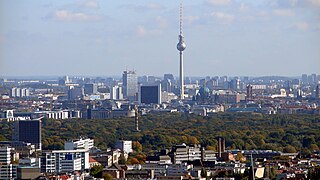
Leinefelde-Worbis is a town in the district of Eichsfeld, in northwestern Thuringia, Germany. The town was formed on March 16, 2004, from the former independent towns Leinefelde and Worbis along with the municipalities of Breitenbach and Wintzingerode. In July 2018 the former municipality of Hundeshagen, and in January 2019 Kallmerode was merged into Leinefelde-Worbis. The population before the amalgamation was 14,387 for Leinefelde, 5,541 for Worbis, 1,021 for Breitenbach and 614 for Wintzingerode. The 10 parts of Leinefelde-Worbis are Leinefelde, Worbis, Breitenbach, Kirchohmfeld, Birkungen, Beuren, Hundeshagen, Kaltohmfeld, Wintzingrode, Kallmerode and Breitenholz.
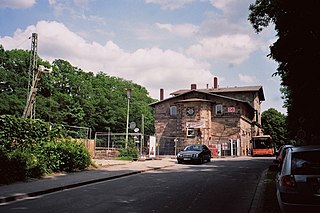
Witzenhausen is a small town in the Werra-Meißner-Kreis in northeastern Hesse, Germany.
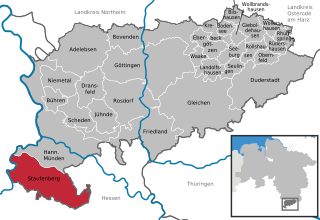
Staufenberg is the southernmost municipality of the district of Göttingen, and of Lower Saxony, Germany. It is situated east of the river Fulda, approx. 6 km south of Hannoversch Münden, and 12 km northeast of Kassel. Its seat is in the village Landwehrhagen.
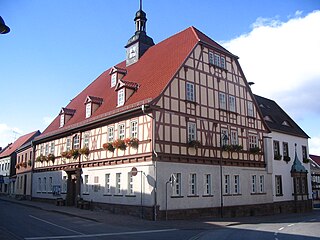
Kelbra is a town the Mansfeld-Südharz district, in Saxony-Anhalt, Germany. It is situated north of the Kyffhäuser mountains, approx. 20 km west of Sangerhausen, and 20 km east of Nordhausen. Kelbra is part of the Verbandsgemeinde Goldene Aue.

The Münden Tunnel is a railway tunnel on the Hanover-Würzburg high-speed rail line in Germany. It is situated south of the town of Hann. Münden between Göttingen and Kassel. At a total length of 10,525 metres, it is the second longest tunnel in Germany after the Landrücken Tunnel. The tunnel was built between 1983 and 1989. At the northern portal, which is located at 51°24′12″N9°42′31″E, the trains cross the valley of the river Werra on the Werra Viaduct at Hedemünden, parallel to the A 7 autobahn. At the southern portal, they cross the Ickelsbach valley, after which the Mühlenkopf Tunnel follows immediately.
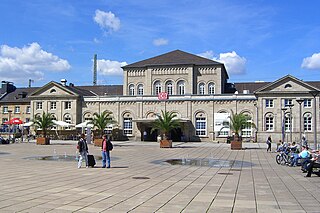
Göttingen railway station, known in German as Bahnhof Göttingen, is an InterCityExpress stop on Germany's domestic long-distance rail network and the only passenger station of the city of Göttingen. Built in 1854 as the terminus of the Hanoverian Southern Railway, the station lies west of the medieval town centre. The station today has four platform islands each with two through tracks. In addition there is a through track for goods traffic between the station building and the platforms.

Berga is a municipality in the Mansfeld-Südharz district, Saxony-Anhalt, Germany.

Krems II is a municipality in the district of Segeberg, in Schleswig-Holstein, Germany. The roman numeral II in the municipality's name served to distinguish it from the nearby Krems I, which is now part of Leezen.

Hedemünden is part of the city Hann. Münden in southern Lower Saxony. Until 1930, it was an independent municipality. About 1500 people live in the village.

The Bramwald is a range of hills up to 408 m above sea level (NN) in the Weser Uplands in Lower Saxony (Germany). It is a unique, natural, wild, hill and forest landscape. This is particularly so in the north around the Totenberg.
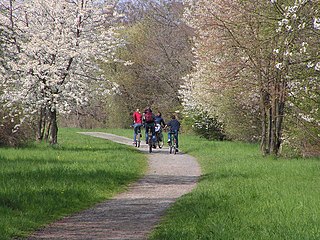
The Weser-Harz-Heide Cycle Route, which is Lower Saxony route no. 5, is a 397 km long-distance cycle path that runs from Hann. Münden, the source of the Weser, over the Harz mountains into the Lüneburg Heath in North Germany.

The Halle-Halle–Hann. Münden railway is a 218 km long main line operated by the Deutsche Bahn in Germany, which links Halle (Saale) in Saxony-Anhalt with Hann. Münden in the state of Lower Saxony. It is mainly used by regional and east-west goods trains. From 1990 to 1994 it was upgraded as part of a German Unification Transport Project.

The Münden Nature Park lies within the district of Göttingen, in south Lower Saxony in Germany.

The Hanoverian Southern Railway is a historical term but it is still a common name for the line between Hanover and Kassel. It is a German main line railway in Lower Saxony and is one of the oldest lines in Germany, opened between 1853 and 1856 by the Royal Hanoverian State Railways.
Anna Marie of Brunswick-Lüneburg was a Duchess of Brunswick-Lüneberg by birth and by marriage Duchess of Prussia.
The Dransfeld Municipal Forest is situated on a ridge in Germany's Central Uplands that ascends to 480 m high. It is located in the district of Göttingen, in South Lower Saxony. Although its name suggests a forest within a town, Dranfeld Municipal Forest is actually a small, heavily forested high ridge that lies about halfway between the city of Göttingen to the northeast and the town of Hann. Münden to the southwest; it is east of the Bramwald and immediately south of the city of Dransfeld. The B3 federal highway runs through the western foothills of the Dransfeld Municipal Forest, located in the northern part of the Münden Nature Park.

The Hoher Hagen is a volcanic hill that is still 480 m high today, in the Dransfeld Municipal Forest, in the German district of Göttingen in South Lower Saxony.
The Göttingen–Bodenfelde railway, also called the Oberweserbahn and in Göttingen the Bodenfelder Bahn, is a standard gauge railway in South Lower Saxony. The single-track, non-electrified branch line runs from Göttingen to Bodenfelde through the Weser Uplands. It is used mainly by local traffic, but it is also used by through traffic. The route was once used, for example, by Düsseldorf–Göttingen traffic.













